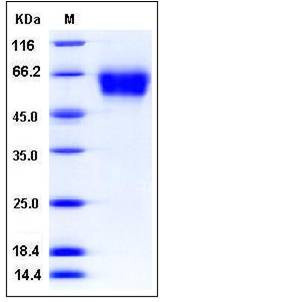Human CD62L / L-Selectin / SELL Protein (His Tag)
CD62L,LAM1,LECAM1,LEU8,LNHR,LSEL,LYAM1,PLNHR,TQ1
- 100ug (NPP3706) Please inquiry
| Catalog Number | P11838-H08H |
|---|---|
| Organism Species | Human |
| Host | Human Cells |
| Synonyms | CD62L,LAM1,LECAM1,LEU8,LNHR,LSEL,LYAM1,PLNHR,TQ1 |
| Molecular Weight | The secreted recombinant human SELL consists of 305 amino acids and predictes a molecular mass of 34.5 kDa. In SDS-PAGE under reducing conditions, the apparent molecular mass of rhSELL is approximately 55-65 kDa due to glycosylation. |
| predicted N | Trp 39 |
| SDS-PAGE |  |
| Purity | > 97 % as determined by SDS-PAGE |
| Protein Construction | A DNA sequence encoding the human SELL (P14151-1) extracellular domain (Met 1-Asn 332) was expressed, with a polyhistidine tag at the C-terminus. |
| Bio-activity | Measured by its ability to bind biotinylated human CD34 in a functional ELISA. |
| Research Area | Signaling |Signal Transduction |Cytoskeleton / ECM |Cell Adhesion |Lectin |C-tyep lectin | |
| Formulation | Lyophilized from sterile PBS, pH 7.4 1. Normally 5 % - 8 % trehalose, mannitol and 0.01% Tween80 are added as protectants before lyophilization. Specific concentrations are included in the hardcopy of COA. |
| Background | L-selectin (SELL), also known as CD62L, is a key adhesion molecule that regulates both the migration of leukocytes at sites of inflammation and the recirculation of lymphocytes between blood and lymphoid tissues. It belongs to the selectin family of proteins, and consisting of a large, highly glycosylated, extracellular domain, a single spanning transmembrane domain and a small cytoplasmic tail. L-selectin is the only selectin expressed on leukocytes and mediates a number of leukocyte-endothelial interactions. L-selectin acts as a "homing receptor" for leukocytes to enter secondary lymphoid tissues via high endothelial venules. Ligands present on endothelial cells will bind to leukocyte expressing L-selectin, slowing leukocyte trafficking through the blood, and facilitating entry into a secondary lymphoid organ at that point. L-selectin-mediated lymphocyte recirculation is required for maintaining the appropriate tissue distribution of lymphocyte subpopulations including naïve and effector subsets such as regulatory T cells. In addition, L-selectin-mediated entry into peripheral lymph nodes is required for optimal induction of lymphocyte homeostatic proliferation during lymphopenia. Importantly, L-selectin has been shown to have both adhesive and signaling functions during leukocyte migration. L-selectin has also been shown to mediate leukocyte recruitment during chronic inflammatory and autoimmune diseases and thus is a potential therapeutic target for drug development. |
| Reference |
